Roadmap: Soil sequestration
Why soil is the next frontier for storing carbon right under our feet.
In the history of agriculture, human farming practices have led to the release of roughly 150 billion tons of carbon dioxide (CO2) from our soils into the atmosphere. To put this into perspective, the average yearly CO2 emissions for an American is 20 tons per person and all cars and trucks in the U.S. emit approximately 1 billion tons of CO2 per year. That currently represents over 7.5 billion tons of CO2 from people and vehicles in the US alone. If the status quo persists, it will take two decades for these two categories to emit the same amount of CO2 that soil has released over the past 12,000 years.
With such a drastic increase in emissions, experts predict that we’ll need to remove 10 billion tons of CO2 each year through 2050 to meet the Paris Agreement goal of limiting climate change to 1.5 degrees Celsius compared to pre-industrial levels. Methods like direct air capture have garnered significant attention, but our soils also hold immense potential as a store of CO2. Experts estimate that soils could store up to 5 billion additional tons of carbon dioxide per year.
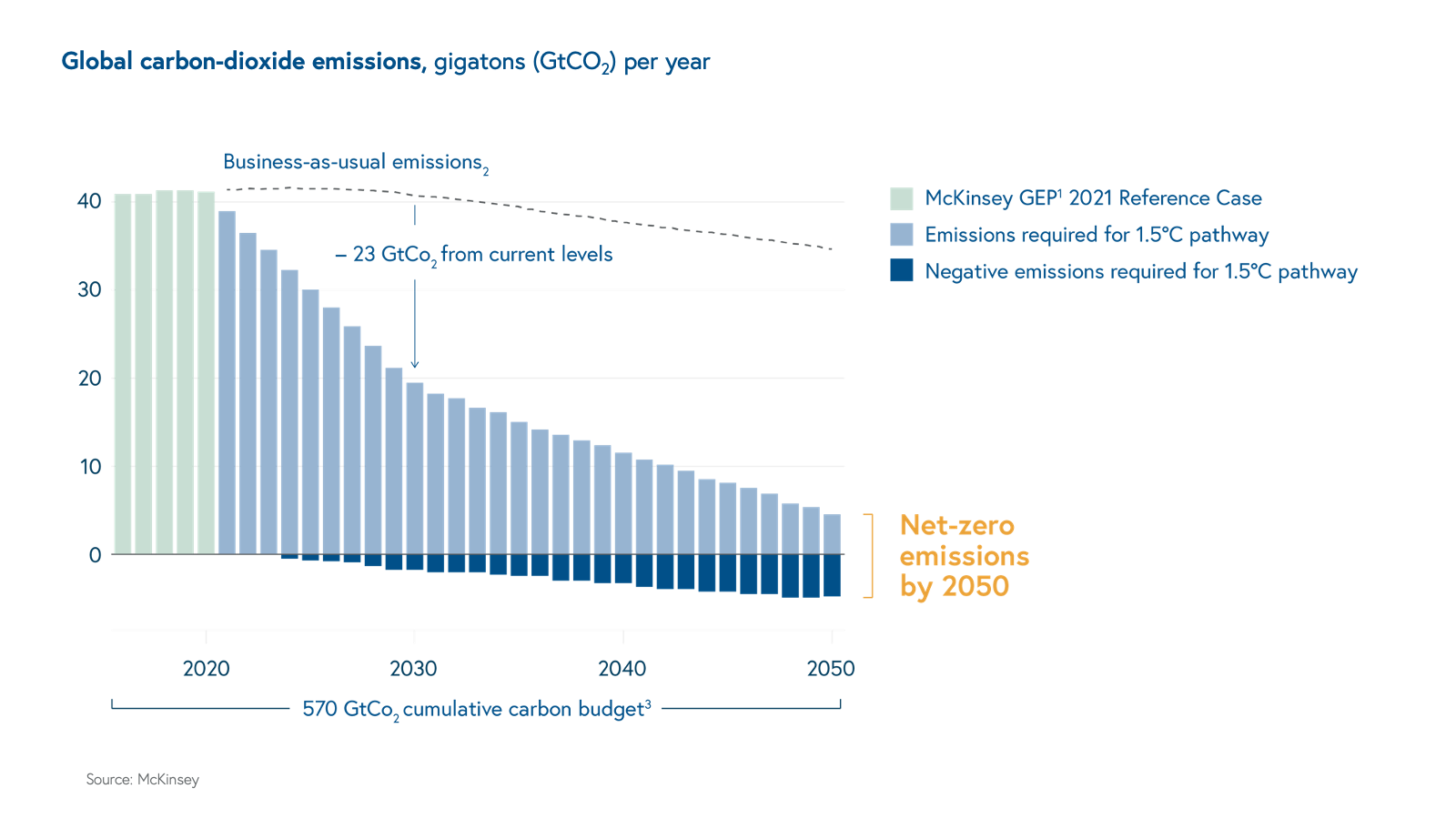
With one of the most promising carbon sinks just one meter right below our feet, it’s no surprise that soil carbon sequestration has recently been a subject of regulatory interest. President Biden has stated that “soil is the next frontier for storing carbon.” The bipartisan Growing Climate Solutions Act, which passed the Senate in mid-2021, would de-risk the process for farmers and forest landowners to participate in voluntary carbon markets. Many states have also passed or are in the process of passing legislation to encourage the growth of healthy soils primed for carbon capture.
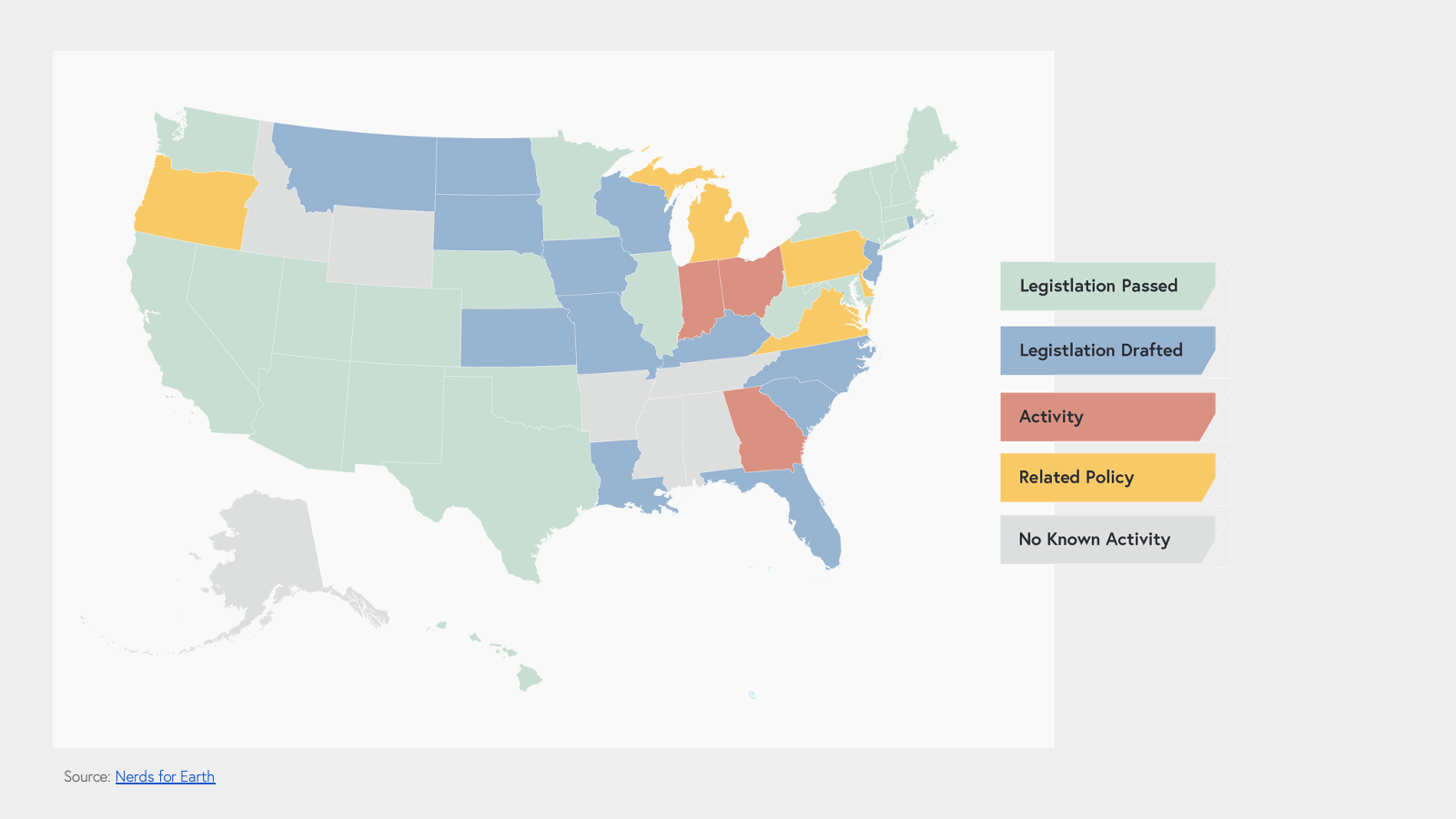
That said, soil carbon sequestration still faces a number of challenges. There are three big projects that environmental scientists need to advance to realize the promise of soil carbon sequestration:
- Sequester more carbon in the ground for longer periods of time
- Accurately measure and report the amount of carbon sequestered
- Evangelize farmers and corporations to adopt practices and technologies that advance soil carbon sequestration
In this roadmap, we’ll share how we’re thinking about the value chain of soil carbon sequestration and where we see emerging opportunities for entrepreneurs building in the space.
How does sequestering carbon in soil work?
The specific biophysics of soil carbon sequestration vary from field to field, owing to the wide diversity of soils and climates across the world. However, in broad strokes, here’s how it works:
1. Storage
Plants consume CO2 from the air, converting it into other organic compounds like glucose. Some of the carbon is stored in the plant itself (as “biomass”), and the rest of it goes into the soil via the plant’s roots. Additional carbon will find its way to the soil through animal waste and plant decomposition.
2. Conversion
Once in the ground, the soil microbiome works its magic. Microbes (like bacteria, fungi, etc.) degrade the organic matter in soil to form humus (not to be confused with hummus, the Mediterranean dip.) Humus is what gives healthy soil its characteristic dark color and is a holy grail for soil carbon sequestration because it’s “recalcitrant” (i.e., can store carbon in soil for hundreds of years.) Other sources of soil carbon, such as dead plant biomass, are less recalcitrant. The efficiency and functioning of the microbiome depends heavily on the composition of other materials in the soil such as nitrogen.
3. Retention
Carbon gets released back into the atmosphere through a number of processes. For instance, microbial respiration will naturally release small amounts of CO2, and human activities like tilling, which disturbs the soil, also releases CO2.
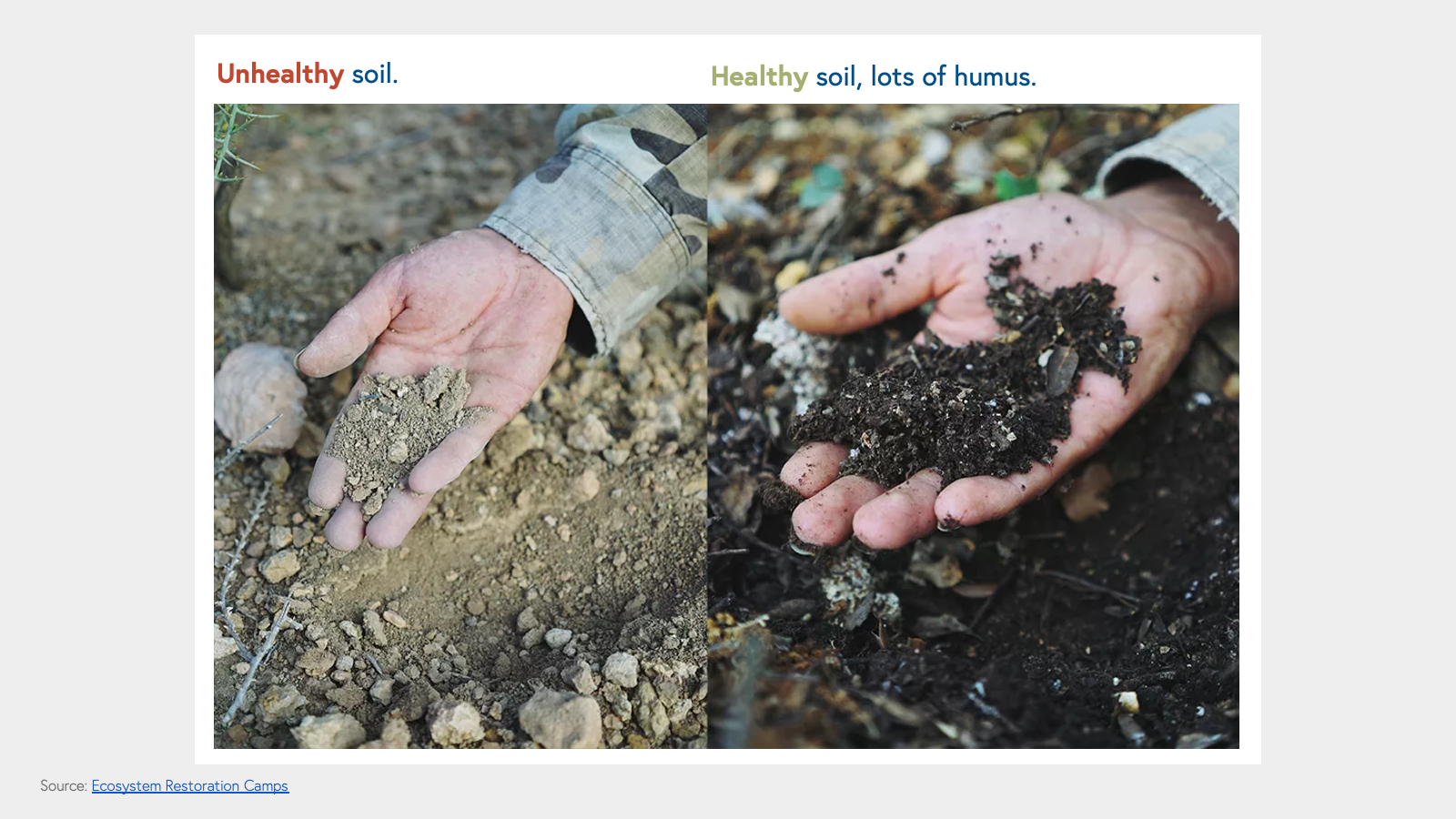
How do we sequester more carbon in our soils?
We can sequester more carbon in our soils by pulling levers related to storage, conversion, and retention. This can take any of the following three forms.
1. Increase carbon intake
Methods to promote plant growth can increase the amount of carbon deposited in the soil. One promising method is biochar, which can increase soil water and nutrient retention. Several companies such as Ecoera, Carbofex, Carbo Culture, and Climate Robotics are all pursuing novel biochar solutions, although the cost to produce biochar remains a major challenge. Agroforestry and reforestation solutions like Dendra and Living Carbon involve planting trees and promoting tree growth, which not only sequesters carbon in forest soil but also captures carbon through biomass.
2. Improve microbiome to increase soil carbon conversion efficiency
A healthy microbiome will not only sequester more carbon for longer periods of time, but it will also improve crop health and yield. Loam Bio is developing different microbial formulations that can easily be coated onto the seeds of various crop types. After crops are planted, the microbes support crop growth and sequester additional carbon. Other companies like Nitricitiy, Pivot Bio, and Kula Bio are developing fertilizers, which use microbes that provide nitrogen, another essential element, to soil. These companies create value for farmers and carbon offset buyers alike.
3. Decrease carbon loss
When we over-farm or till the soil, carbon escapes the soil and enters the atmosphere. We can decrease carbon loss by encouraging farmers to adopt more sustainable practices. Additionally, we can tackle carbon loss by preventing or mitigating natural processes like erosion and microbial respiration.
Companies that are working on ways to sequester more carbon in our soils need to consider farmer friction. Some methods, like no-till farming and the introduction of livestock, require farmers to fundamentally change some of their day-to-day farming practices, which is not always realistic. These methods, which perhaps are more appropriately called agricultural practices rather than new technologies, may have lower adoption rates. As such, these practices are better suited for project developers rather than venture-backed startups. Indeed, the role of project developers in the soil carbon space is to cultivate a high-touch relationship with farmers in helping them implement practices to earn carbon credits.
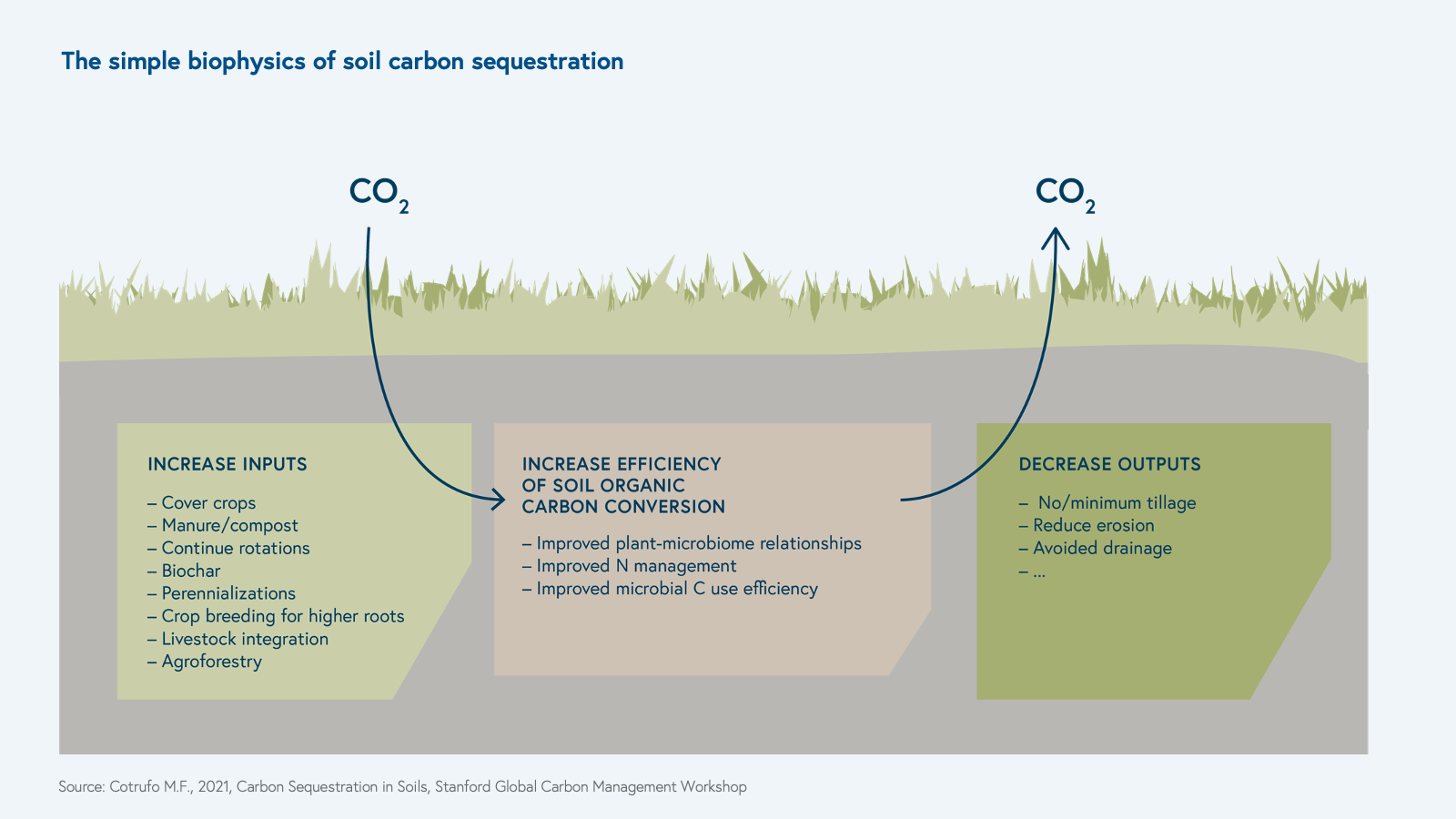
How do we monitor, report, and verify carbon levels?
Another vexing challenge with soil carbon sequestration is the measurement, reporting, and verification (MRV) of carbon stored in our soils from acre to acre. As mentioned, soil carbon content varies substantially across soil depth, individual plots, spatial locations within a plot, and time. While the good news is that we already technically know how to do this with high accuracy, the bad news is that it is manual, time-intensive, and extremely expensive. The cost of MRV is about 75% the total cost of generating soil carbon credits, and Australia, one of the leading countries for soil carbon sequestration due to its government-backed MRV protocol, has a stretch goal to reduce the cost of MRV from $30/hectare ($12.15/acre) to $3/hectare ($1.22/acre).
To drive costs down while preserving accuracy, we’ve seen companies adopting the following approaches:
Ex-situ measurements: Existing methods of testing for soil carbon levels involve taking physical samples (“soil cores”) and mailing them to a lab for carbon analysis. This is an arduous process, especially for small-and medium-sized farms. Companies are actively working to make ex-situ measurements more efficient and accessible. For example, LaserAg, the winner of Indigo’s soil MRV challenge, has built a lab technology to analyze a host of soil parameters in less than one minute.
AI + remote sensing: Companies like Perennial and Regrow use satellites and drones to capture optical and hyperspectral imagery of agricultural fields. These companies build proprietary machine learning models trained on a number of physical soil samples. Combining the aerial imagery with the machine learning models, they can extrapolate at scale the soil carbon levels of a tract of land (e.g., from the color of the soil). However, remote sensor data collection struggles to capture data beneath the soil’s surface and often still requires manual verification afterwards. Perennial and Regrow represent two companies pioneering methods of overcoming challenges of low accuracy/resolution historically associated with remote sensors.
In-situ measurements: Companies are developing ways to measure carbon levels directly on-site without needing to mail samples to labs. Our portfolio company Aigen is building solar-powered robots that autonomously traverse agricultural fields to measure carbon content while helping farmers reduce herbicide dependency. Yard Stick PBC offers a hand-held spectral probe to measure soil carbon levels and bulk density, while EarthOptics integrates a novel sensor with tractor OEMs. These methods are less accurate than lab analysis on a per-sample basis, but their low cost per sample site enables denser sampling coverage, resulting in similar accuracy on a per-field or per-project basis. Still, other novel technologies are currently making their way from the lab into practice. For example, companies have been exploring neutron-gamma analysis, which involves bombarding the ground with neutrons and measuring the resulting gamma rays when nuclei in the soil capture those neutrons. Overall, in-situ measurement methods may be more accurate than remote sensing methods, although their technological readiness levels are lower.
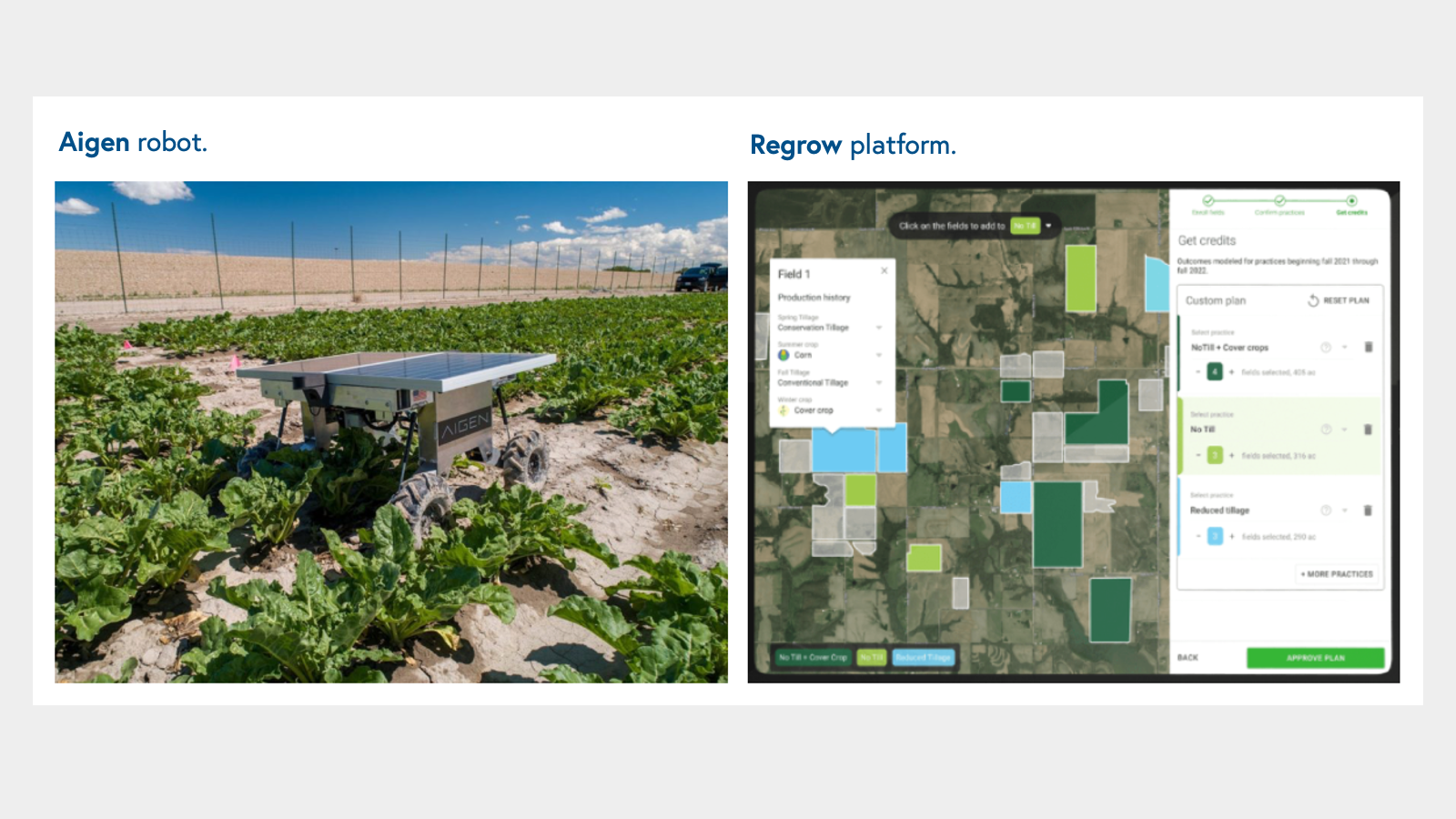
Who are the key stakeholders and potential customers?
The agricultural industry has historically faced headwinds in new technology adoption, but the industry has been facing pressure from all sides to modernize. From a consumer perspective, the public is demanding that agriculture adopt more sustainable practices. From an economic perspective, farms seek new income streams (e.g., with carbon removal credits) in response to squeezed margins and increasing debt burdens.
From a regulatory perspective, the government is enacting programs to build new farming infrastructure. The USDA recently announced $1 billion in funding for the adoption of climate-smart farming technologies and novel soil carbon MRV solutions. In combination, consumer pressure, economic diversification, and regulatory programs are easing the go-to-market motion for startups selling into the agriculture industry. Indeed, agtech funding has surged over 1000x, from just $3M in 2011 to over $5B in 2021. We’ve seen soil carbon sequestration companies adopt the following sales motions:
B2B: Many corporate entities, and especially agricultural corporations (e.g., companies that make and sell fertilizer, seeds, and chemicals), have their own plots of land for R&D. However, the business units within these companies that are in charge of managing agricultural land may take a backseat to the main revenue drivers. Furthermore, in the long-run, startups likely won’t be able to rely on such businesses alone without having their sales motion touch farmers in some capacity. While companies like Syngenta, Bayer, and Nutrien themselves collectively own tens of thousands of acres of agricultural land, farmers worldwide till millions of acres of farmland.
B2B2F: Some businesses and project developers own direct relationships with networks of farmers. These businesses can then get their farmers to adopt novel soil carbon sequestration and MRV solutions. Oftentimes, these companies (e.g., CPGs like Oatly or food processors like Cargill) have sustainability budgets and subsidize costs for farmers. Most startups in the space have chosen the B2B2F model, as it abstracts away the difficulty of selling directly to farmers (see below). Businesses with wide farmer networks are also eager to partner with new technology solutions while they clean up their supply chains.
B2F: Companies can also directly own the relationship with farmers rather than using other companies as intermediaries. This comes with a host of advantages, including increased goodwill, trust, brand, and stickiness among farmers. However, the farmer ROI needs to be abundantly clear. The upside is that farmers can earn more income from carbon credits, and regenerative agricultural practices can lead to improved crop yield and quality. Nevertheless, these benefits aren’t immediate to the farmer, as they require at least a season of growing before realizing the ROI. If companies are able to find innovative ways to protect farmer downside (e.g., through insurance) or deliver immediate financial benefit to farmers (e.g., through upfront payments), these might grease the wheels on the sale. Rather than selling from individual farmer to farmer, companies here should get pods of farmers occupying adjacent land to adopt a new technology, as farmers can distribute the risk among such pods.
Even if farmers and corporations are able to sequester more carbon in their fields, and even if they get highly accurate measurements of soil carbon sequestration levels for those fields, the process isn’t over. We still need neutral third-party “verifiers” to develop generally-accepted protocols for assessing soil carbon levels. CarbonPlan, an excellent carbon removal research non-profit, keeps an ongoing scorecard of such soil carbon protocols. After verification, soil carbon sequestration levels are communicated to the voluntary carbon markets, where buyers can purchase soil carbon credits to offset their emissions.
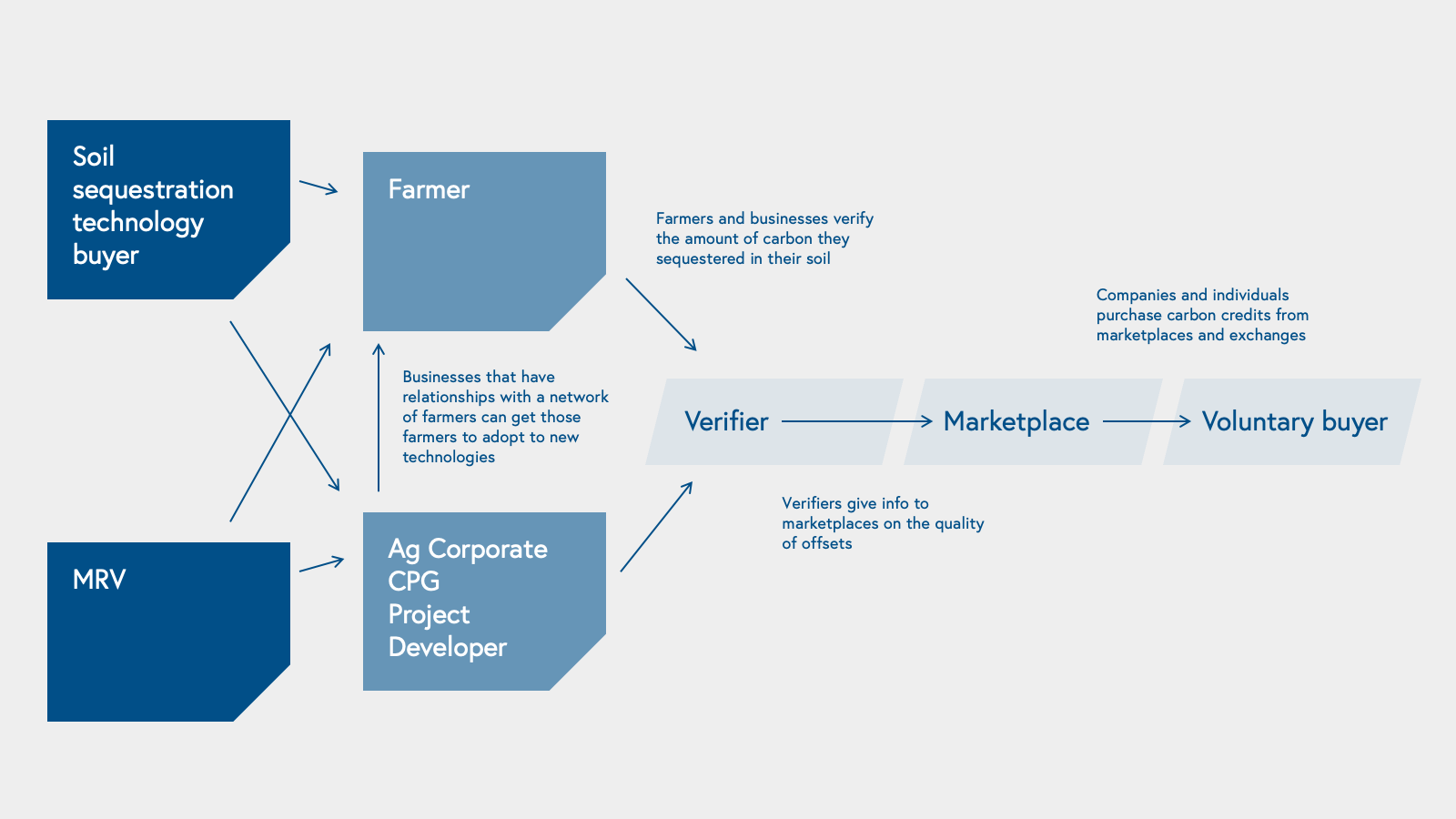
Putting carbon back where it belongs for a better future
Soil has been sequestering carbon now for the entirety of human history (and even earlier). But the last few centuries have undone some of the legacy benefits. With climate change threatening our species, we should be intentional about re-sequestering carbon in our soils. We can only do that with more innovative soil sequestration methods, more accurate ways to monitor and report soil carbon levels, and more frictionless business models so businesses and farmers can quickly and painlessly adopt these new technologies. We see an abundance of opportunities to improve the soil sequestration process and build a category defining business.
The National Resources Defense Council estimates agricultural soil could sequester up to 250 million metric tons of CO2 emissions annually. By putting carbon back where it belongs, in our soils, we can go a long way towards mitigating and undoing climate change. If you are building a company that you feel resonates with the themes described in this article, please email us at climate@bvp.com. We’d love to help make your vision a reality.





